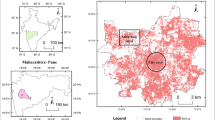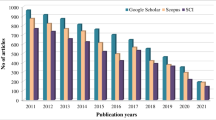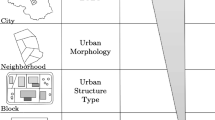Abstract
This paper introduces an advanced method based on remote sensing and Geographic Information System for urban open space extraction combining spectral and geometric characteristics. From both semantic and remote sensing perspectives, a hybrid hierarchy structure and class organization of open space are issues and mapped from one to another. Based on per-pixel and segmentation mechanism separately, two classification approaches are performed. Owing to prior of spatial aggregation and spectral contribution, the segmentation-based classification exhibits its superiority over a pixel-based classification. Finally a GIS-based post procedure is hired to eliminate some unsuitable open space components in both spatial and numerical constraints on the one hand, and separate open space some fabrics from fused remote sensing classes by defining their Shape Index on the other hand. The case study of Beer Sheva based on ASTER data proves this method is a feasible way for open space extraction.
Similar content being viewed by others
References
Sabins F F (1996) Remote sensing principles and interpretation. New York: W. H. Freeman and Company.
Cross A M, Mason D C (1988) Segmentation of remotesensed images by split-and-merge process.International Journal of Remote Sensing, 9(8):1329–1345
Kok R D, Buck A, Schneider T, et al. (2000) Analysis of image objects from VHR imagery for forest GIS updating in the Bavarian Alps. XIX Congress of the International Society for Photogrammetry and Remote Sensing (ISPRS), Amsterdam.
Medda F, Nijkamp P, Rietveld P (1998) Recognition and classification of urban shapes.Geographical Analysis, 30(3):304–314
Xia L (1996) A method for improve classification with shape information.International Journal of Remote Sensing, 17(8):1473–1481
Abrams M (2000) The advanced spaceborne thermal emission and reflection radiometer (ASTER): data products for the high spatial resolution imager on NASA’s Terra platform.International Journal of Remote Sensing, 21(5):847–859
Elachi C (1988) Spaceborne sadar remote sensing: applications and techniques. New York: IEEE Geoscience and Remote Sensing Society.
Brower S, Dockett K, Taylor R (1983) Residents perceptions of territorial features and perceived local threat.Environment and Behavior, 15:419–426
Chabier Y V (1985) The greening of copley square.Landscape Architecture, 75(6):70–76
Eubank-Ahrens B (1985) The impact of woonerven on children’s behavior.Children’s Environments Quarterly, 1:39–45
Hayward D, Rothenberg M, Beasley R (1974) Children’s play and urban playground types: a comparison of traditional contemporary, and advanture play-ground types.Environment and Behavior, 6:131–168
Lillesand T M, Kiefer R W (1994) Remote sensning and image interpretation. New York: John Wiley & Sons, Inc.
Lynch K (1981) A theory of good city form. Cambridge: MIT Press.
Author information
Authors and Affiliations
Additional information
Funded by the Scientific Research Foundation for the Returned Overseas Chinese Scholars.
About this article
Cite this article
Guobin, Z., Blumberg, D.G. An urban open space extraction method: Combining spectral and geometric characteristics. Geo-spat. Inf. Sci. 7, 249–254 (2004). https://doi.org/10.1007/BF02828547
Received:
Issue Date:
DOI: https://doi.org/10.1007/BF02828547




